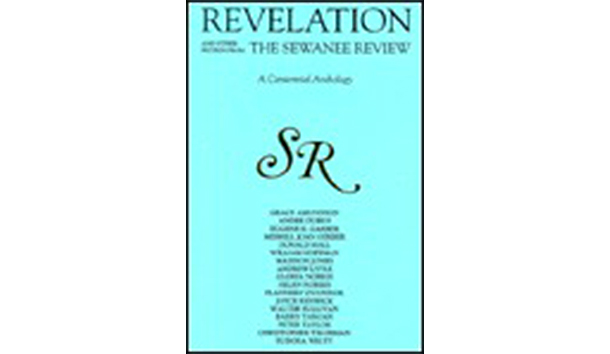This volume of short stories seems to me to represent, as a book, two distinct levels of meaning. The first and most insistent of these levels is of course as a diverse gathering of brilliant fictions, each one a self-justifying experience. The variety of voices and subjects is itself refreshing and rewarding; the high standard of excellence suggests that the inclusion of each story was a judgment made by an informed and discriminating intelligence.
The multiple juxtapositions strike many sparks, but before I remark on some of those specific flashes of illumination, I want to point to a second but no means negligible level of meaning implied by this anthology. I refer specifically to Revelation as a centennial anthology and to the literary tradition or association that is celebrated by this gathering of stories. The volume is a part of the centennial of the Sewanee Review that was observed last fall, and more. It commemorates the superb fiction that has been published by the review for five decades, since Andrew Lytle and the late Allen Tate began there in the 1940’s. John Palmer continued the practice, as did Monroe Spears in the 1950’s. Andrew Lytle maintained the standard he himself had set during his second editorship, from 1961 to 1973. Since then, George Core has, to say the least, maintained the tradition for 20 more years.
In this context, we must be reminded of Andrew Lytle’s anthology of 1971, Craft and Vision, which, like George Core’s, contains 17 works from the Sewanee Review. I hasten to say that these collections have only one story in common, Andrew Lytle’s “The Guide,” or as he called it later, “The Mahogany Frame.” There are some writers in common here, naturally enough: Eudora Welty, Peter Taylor, Flannery O’Connor, and Madison Jones are four of the best in the history of American literature and are represented as they should or even must be—though not by the same stories.
Back in 1971, Mr. Lytle included works by William Faulkner, Caroline Gordon, and Robert Penn Warren, for obvious reasons. But now George Core, while not scanting the past, has chosen more contemporary works from perhaps a wider range of writers, reflecting his own editorial presence. Reading Andrew Lytle’s 1971 foreword, I find many of the distinctions he made then to be still valid for the editor of this distinguished literary quarterly but also still unheeded by a nation that seems preoccupied with bad fiction, worse movies, aesthetic quota systems, and artistic set-asides. Lytle declared, “The stories are written out of a conscious use of the craft. As widely different as are the subjects and styles, this fiction represents the oldest tradition in the world, the perpetual understanding of the human predicament and the sense that it can only be imparted formally In the end the sudden discovery of form and subject conjoined is a mystery. It is instantaneous; and nobody, including the author, takes in quite how the two fuse and thus allow the drama to unfold.” What he said then still goes. And that what Mr. Lytle called “an excellence which will sustain this magazine’s tradition . . . this formal sense of craftsmanship” is still a vital criterion at Sewanee, as George Core has made perfectly clear.
There is a sense of tradition, then, in Core’s anthology, not only in the excellence that we now come to expect, but also in the presence of artistic connections. Flannery O’Connor, Walter Sullivan, Madison Jones, and Merrill Joan Gerber, for instance, all studied the craft of fiction with Andrew Lytle. Eudora Welty and Peter Taylor have known him for a long time and share a certain collegiality with him. Other writers belong to other regions, perhaps, or have modulated their tones in different ways, or have opened their stories to different realms of experience, but they still adhere to the demands of excellence as George Core has defined them: “[E]ach has the constituents of strong fiction: a compelling story, a credible action and an inevitable plot, character expressed and exposed (as Henry James would say), sharp detail and acute description properly subordinated to action and plot. The engine driving the plot and revealing its causality as the action unfolds is the story itself, what James calls the ‘irresistible determinant,’ ‘the prime and precious thing’—the element providing the fundamental energy and combustion for the fictive occasion. That ingredient I particularly commend to you.”
He has commended to us the stories in this volume as well. In recommending them, I would like to confine myself here to certain remarks that I have meant to apply broadly to this volume as well as to particular writers. I have found Flannery O’Connor’s “Revelation” to take on a new resonance in this context. Walter Sullivan’s “Elizabeth” seems to share with O’Connor’s story a sense of mystery, and Madison Jones’s “Zoo” a quality of serious fun that suggests a commonality that is not only literary but regional and even spiritual.
George Core’s own declaration effectively dramatizes what I have merely attempted to indicate: “I would put this selection of stories up against any other without the slightest embarrassment or even a trace of defensiveness, arguing that it is better than any comparable anthology published during the last decade and more. What I especially savor as a reader is the richness and diversity these stories offer.” Barry Targan’s “Kingdoms” proves his point about the diversity, for that effective work is open and free in form compared with some of the more traditionally shaped ones. As for the rest of his claim, the editor of Revelation gets no argument from me.
[Revelation and Other Fiction From the Sewanee Review: A Centennial Anthology, Edited by George Core (Louisville: Harmony House) 304 pp., $24.95]

Leave a Reply